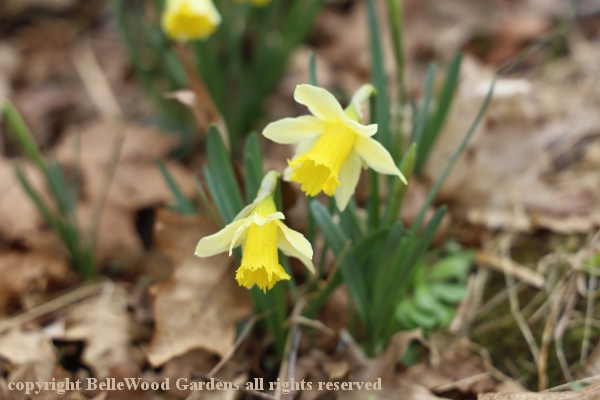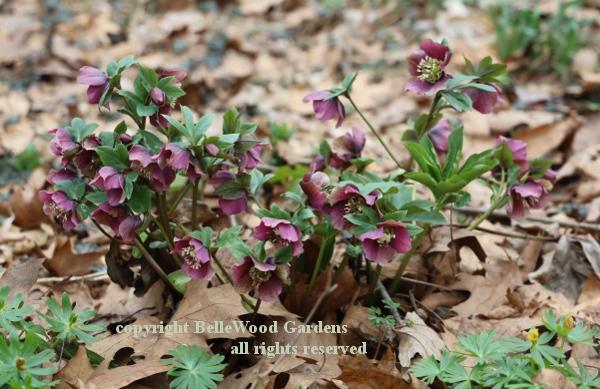| March | ||
| April | May | June |
| July | August | |
Wednesday, 18 August 2021

One more pink August lily to show you. Magic or surprise lily, Lycoris squamigera.
Leaves appear in spring, then fade away. Hey presto, in August come the flowers.

×Amarcrinum is interesting bi-generic hybrid between amaryllis and crinum.
Easily told from its crinum parent as the pink flowers are more upward and
outward facing than those of their crinum parent, and of better substance.
Saturday, 14 August 2021

Last year I divided my Crinum ×powellii. Gave away some of the smaller
bulbs and repotted the largest one on its own. It now has a massive girth,
well in flower on a tall, sturdy stalk, separate from the sturdy pseudostem.

I grow Canna 'Pretoria' (unless it is 'Bengal Tiger') for its handsome
yellow striped leaves. The hot orange flowers are more of a lagniappe.
Tuesday, 27 July 2021

Temperatures in the 90s Fahrenheit, and lots of rain. My hardy bananas,
Musa basjoo, is overjoyed. Don't think they have been so vigorous before.

Mexican shell flower or tiger flower, Tigridia pavonia, is a beautiful, unusual corm from Mexico. I used to find the dormant corms in Big Box stores in the spring. Not this year. Ordered some 10 packs on line, mixed colors. So far only two have flowered, and both were red. This particular flower is aberent, with four petals where there should be only three.
Friday, 23 July 2021
There are all sorts of summer bulbs. Some are hardy and stay in the ground year-round. Others are tender, here in New Jersey. They should be dug and stored over the winter.

White rain lily, flower of the west wind, Zephyranthes candida, thrives
with wet feet. In the summer I keep the pots in shallow trays with water.
Tuesday, 20 July 2021

Elephant ear, Colocasia esculenta, is a bold tropical plant. You can find the tubers for sale both in garden centers, and also in the supermarket in the produce department. These in my garden are enjoying the hot, wet summer weather. The vein down the center of the leaf is as long as my arm from finger tip to elbow. And the leaf has two "ears" that make it even longer.

Crocosmia 'Lucifer' is surprisingly hardy for a corm from the grasslands of
South Africa. It does well for me here in New Jersey and winters over too.

This summer I paired it up with Canna 'Tropicana', which is tender.
Monday, 5 July 2021

Eucomis pallidiflora is delightfully in bloom. I had bought this bulb quite a few years ago as E. pole-evansii but just this summer I have been assured that pole-evansii is much larger (as much as 6 feet tall!) and quicker to make offsets. My plant has only doubled in all the many years I have had it. I have also seen it identified as E. pallidiflora ssp. pole-evansii.
Sunday, 20 June 2021

Evergreen Agapanthus 'Peter Pan' is a dainty cultivar suitable for
limited greenhouse space, only growing about 12- to 18-inches tall.

Monday, 14 June 2021
As I turned my car into the driveway a black vulture flew up from the ground and perched on a low branch. "Aha!" I thought to myself and walked over. Sure enough,

Voodoo lily, Dracunculus vulgaris is in perfect bloom.
The vulture is interesting because A) never, that I'm aware of, have vultures investigated it previously and B) neighborhood dogs seem immune to its olfactory lure.
As we continued up the driveway Paul quietly commented, "I'm really glad you did not plant it near the house." Yes, the powerful stench of rotting meat is best appreciated at a distance.
Sunday, 6 June 2021

Itoh hybrids, these yellow peonies are intersectional crosses of woody stemmed
Lutea Hybrid tree peonies with the familiar Lactiflora herbaceous peonies. Beautiful!


A perennial foxglove with soft pale yellow flowers, Digitalis lutea
self sows on the slope beyond the greenhouse and welcome to do so.

Rattlebush, for its silver gray pods with loose seeds. They will come
in autumn, after the pea-like Baptisia australus flowers are done.
This is the once every 17 year major eruption of Brood X cicadas.

They shrill their mating calls. Eggs are laid in twigs high in the trees. Hatch, drop to the ground, burrow down to the tree roots, and remain there in the dark for 17 years. Tunnel to the surface and emerge. Molt to adult form. Just a few weeks in the sunlight to renew the cycle, then die.

Latest banana update: early June, bananas are approaching luxurious.
Saturday, 29 May 2021

The weather is hot. It's humid. Been raining. And the banana plants
are loving it. They've grown so much they're peering in the window.
Friday, 28 May 2021

Old man's beard, Chionanthus virginicus, veils itself with a haze

of thread-fine white petals. Trees are either male or female. Like us.

Lemon lily, Hemerocallis lilio-asphodelus, is an earlier flowering
species day lily. There were many buds. Deer came. Few flowers.

Strange flower of Sauromatum guttatum. Surprisingly hardy.
Note: purple leaves are shiso, Perilla frutescens, not voodoo lily.

Not noticeably stinky though flies certainly find it appealing.
Sunday, 23 May 2021

Eighteen days since the covers came off, and all the Musa basjoo
are wakening up and stretching skywards. But this is just the start.

No, not a deutzia. This is Kolkwitzia amabilis 'Dream Catcher'
an easy care shrub with chartreuse leaves and soft pink flowers.


Some pots of rex begonia 'Moonlight' happy to be out of the greenhouse
for the summer. I did mean to plant them with Japanese painted fern, but
just did not get around to it. No matter, they look quite good in their pots.

No idea what cultivar this columbine might be. All I know is that it thrives,
even to the extent of seeding about, vigorously. I have to weed the excess.

Very attractive, reliable and vigorous, Paeonia 'Illini Warrior' is an early season
herbaceous peony. I like the contrast of golden stamens and rich red petals.

Friday, 14 May 2021
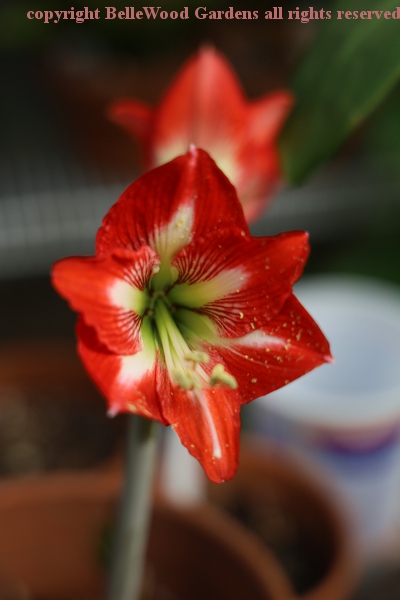
My hippeastrum do rebloom, but never in winter. 'Baby Star' prefers late spring.

'Early Scout' is a cross from dwarf, fern leaved Paeonia tenuifolia which
provided delicate foliage, shorter growth, and early vivid red single flowers.
Friday, 7 May 2021

Rhododendron yakusimanum has a velvety indumentum, a fuzzy velvety
layer on the underside of its leaves. Which must make it unpleasant to eat.
Because deer mostly leave it alone and I get to enjoy the rose-pink flowers.

Evergreen and spreading, Phlox stolonifera 'Sherwood Purple' is
a fine companion for other perennials. Native too, as are all phlox.

Arisaema thunbergii variety urashima is one of the Japanese arisaema, and I think my favorite of those I grow. The Latin name of the species is for Carl Peter Thunberg , a Swedish botanist who was employed as a surgeon by the Dutch East India Company in the latter part of the 18th century.
Notice the long flagellum on the spadix, looking similar to a fishing line. I suppose that is responsible for the charming folk tale a Japanese friend told to me,

Taro Urashima was a fisherman. One day he saw some children tormenting a sea turtle. Being a lad with a kind heart, he rescued the turtle. Well, you know this sort of story goes. It was a magic turtle who brought him to the kingdom under the sea where he had a wonderful time. But eventually he wanted to go home.
"Stay, do stay!" the lovely sea maidens begged him. "No, I really must go." he firmly replied. So they heaped him with treasure. And gave him a small box, together with a warning never to open the box. Always with these little gift boxes, never to be opened.
He came back to the harbor but everything had changed. He recognized not one of the people because so much time had passed. Opening the little box Taro Urashima suddenly became an old man and died. Because time passes differently in the kingdom under the sea - or in the fairies barrow under the hill, right?
Thursday, 6 May 2021

Wild sweet William, Phlox divaricata, is a lovely shade tolerant
native perennial. Here it is partnered up with a sessile trillium.
Wednesday, 5 May 2021
A new month. The trees are green, tender vivid green, closing over the forest floor, concealing and screening away the neighbors' houses.

It's time. We took the plywood covers off, and the tubs over the bananas.
They have begun to grow, more enthusiastically now they are uncovered.

I raised this red buckeye from seed. Not quite sure whether it is
Aesculus pavia or A. ×briotti. Whichever, it's flowers are lovely.

Strange looking flowers on Carolina allspice, Calycanthus floridus.
Native to southeastern United States, it spreads by suckering habit.

Viburnum plicatum 'Mariesii' has neatly layered appearance, accented with
lacy white flowers at this time of year. Neat, tidy, and elegant, a good accent shrub.

Trillium erectum 'Album' or possibly forma albidum is the white form
of the typically ox-blood red native trillium. Various common names
are wake robin, wet dog trillium, stinking Benjamin, and birth root.

Wild sweet William, Phlox divaricata, is a clump forming deciduous, native
woodland perennial. In shade, a a companion for other plants, like trillium.

Sensitive fern, Onoclea sensibilis, is a vigorously spreading native with lush
tropical appearance. I potted some up when digging them out last year. And
discovered that they wintered over with no extra protection. I will again pair
them with bold foliage summer tropicals such as cannas and elephant ears.

Speaking of treasures, silver and pewter Athyrium niponicum 'Pictum' looks very
metallic. The common name for this is Japanese painted fern. Hardy, deciduous.
I provide them with silver leaved rex begonias as summer companions in shade.

Arisarum proboscideum is a sweet little aroid with the common name of
mouse tail arum. Winter hardy, summer dormant. Deer don't eat it - crystals
of oxalic acid in all aroids are protective. I really should grow some in a pot.
Saturday, 1 May 2021

Quince, this shrub is called, flowering quince. But the trees whose fruit
I use for sweet quince preserves are Cydonia, or Pseudocydonia. The shrub
is Chaenomeles japonica. Vivid brick red-orange is the common color for its
flowers. I prefer the soft coral pink of 'Cameo'. And yes, if it fruits, use for jam.
Friday, 30 April 2021
The last day of April. A mere 30 days. Looking at what is in flower today and what was in flower at the start of the month makes it seem that it must have been longer. The only thread weaving through is the daffodils, narcissus early and late. As I drive around town I see that magnolias and early flowering cherries are over. Crab apples are in bloom. Fruit trees too, such as peaches. It's a wonderful time of year.

Jetbead, Rhodotypos scandens, is an old fashioned shrub. Likes shade, good doer,
deer ignore it. Spring's flowers are followed by jet black berries that stay through winter.


'Foundling' is another, a cross of 'Irish Rose' and 'Jenny'.
Has to have N. cyclamineus somewhere in there also.
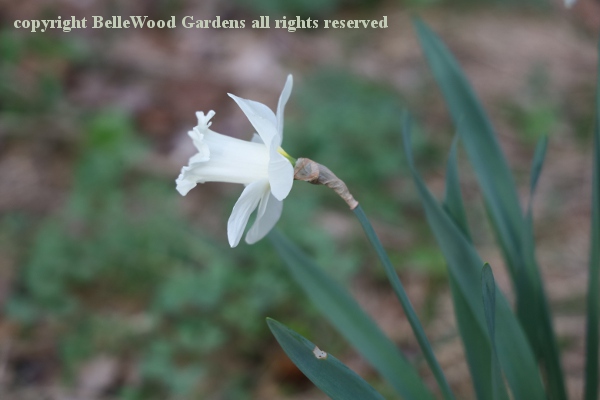
Narcissus 'Mount Hood' has substantial, pale cream flowers when first open,
tipping slightly upward and maturing to pristine white. Bred in Holland in 1930.
 .
.
The last narcissus are closing out the season of spring bulbs. This is the aptly named 'Polar Ice'.

Japanese woodland peony, Paeonia obovata 'Alba' is earliest peony to flower
here at BelleWood Gardens. It's happy here. Must be, because is seeds about.

Bright fuchsia Primula kisoana was just starting into flower a week ago.
They are now reaching their peak and I could not resist sharing again.
Friday, 23 April 2021

I think this is my favorite primrose. It is Primula kisoana, from Japan. It spreads
with barely subsurface runners, has fuzzy leaves shaped like a maple, and these
wonderfully vivid, fuchsia colored flowers. Loves the woodland, winter dormant.

Bleeding heart used to have the Latin name of Dicentra spectablis. It has now
been shifted to genus of its own, and referred to as Lamprocapnos spectabilis.

This picture is deceiving as the wildflower is only a few inches tall.
It is Anemonella thalictroides, sort of like an anemone flower
with leaves somewhat like those of a thalictrum. See, easy Latin.

Summer snowflake, Leucojum aestivum. Yes, it is later than spring snowflake
which flowered in mid-March. Somewhat later April is not summer, now is it.

Introduced over 100 years ago, in 1916, Narcissus 'Thalia' is an
elegant triandrus cultivar with two or three nodding pure white
flowers. It is long lived in both casual woodland or formal border.

I had lost the label for this rather attractive pink trumpet daffodil. I asked,
and my friend Jim Waddick in chilly Kansas City, Missouri (zone 5) said that
if it is not especially new and is a good grower he think it is 'Pink Charm'.
Wednesday, 21 April 2021

Narcissus poeticus is prepotent, stamps all its offspring with tiny ruffled cup banded
green, yellow, red at the edge, showy against pristine white petals. But which one this
is - 'Old Pheasant Eye', 'Felindre', or award of garden merit 'Actaea' I cannot really say.
I planted them more than 20 years ago. Perhaps Narcissus poeticus var. recurvus will do.

Friday, 16 April 2021
Flowers appear in my garden overnight. They appear between morning and night. I think they appear as I turn around. After all, it's spring. Of course a mild sunny day speeds things up.

The earliest flowers are always the "foreign" bulbs - snowdrops, crocus.
Hyacinth 'Carnegie' displays pristine white flowers on an overcast day.

Daffodils are all mixed up with their appearances this spring. The typically early
'Rijnveld's Early Sensation' appeared late, on 2 April. These Narcissus poeticus
cultivars usually - in early May, not mid-April. Oh well, at least they are flowering.

Another little bulb, this is Fritillaria meleagris, Guinea hen flower,
checkered lily or leper lily - the last for bells that lepers had to carry.

Does Latin, which language is used for naming plants, intimidate you? Fret not. This spring flowering, silver spotted evergreen perennial is commonly named as lungwort. In Latin, Pulmonaria. See, it's easy Why was it given the matching names? Because, according to the Doctrine of Signatures, its spotted leaves resemble diseased lungs. Therefore, it should be suitable to treat conditions and diseases such as coughs, catarrh, pneumonia, tuberculosis. I would be cautious about using P. saccharata to treat anything and just enjoy it as a charming plant in the garden.

A different species from the spotted leaf kind mentioned above. Its leaves are
plain green, and its flowers a clear rosy red in bud and bloom. This is P. rubra.

Not a lungwort. The sky blue flowers belong to our native Virginia bluebells,
Mertensia virginica. Evenescent, it quietly fades away in late spring.
It is growing here with another native, Trillium cuneatum, which stays.

Twinleaf, Jeffersonia diphylla, drops its petals nearly as soon as
its flowers open. I like the leaflets that provide its common name.

Trillium grandiflorum has a peduncule between leaves and flower.
This differentiates it from the sessile species such as T. cuneatum.

Helleborus foetidus is a caulescent hellebore, a species with stems.
Apple green flowers form in fall, open to small bells early in the year.
Best to cut back flower stems to encourage new leaf growth. Here
I partnered it with Arum italicum 'Pictum', which is also winter green.

Originally planted in a round chimney liner section, I should have known
that Petasites japonicus 'Variegatus' would soon escape, and start to
spread along the seasonal brook's bank. Decided that's O.K., and enjoy it.
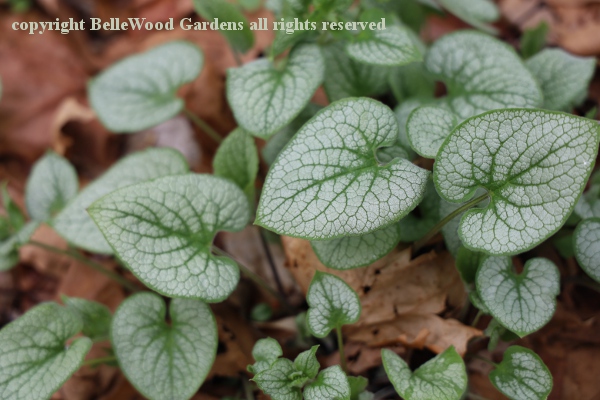
The flowers of false forget-me-not, Brunnera macrophylla, have not yet made their
appearance. No matter, green netted silver flushed leaves of 'Jack Frost' pays the rent
for space in my garden. Better yet, it seeds true from seed. Just transplant while small.

Pachysandra is not a boring plant. Just because it is rolled out like a green carpet
around office buildings - it's the use that's boring. As well as plain green there is a
glossy version. And also this pleasing cultivar, Pachysandra terminalis 'White Edge'.
In the Greenhouse

Things are rather quiet in my greenhouse. Winter growing bulbs such as freesia, lachenalia, oxalis, and rhodophiala are mostly dormant. I'm potting dormant-starting-to-awaken mirabilis and the pelargonium cuttings. And this rather oversize pot of Oxalis regnellii that was out of the way under a bench . . . nope, not any longer. It has happily hurled itself into lush growth and needed a move into the light.
Saturday, 10 April 2021

Doretta Klaber wrote a lovely book with the title Primroses and Spring.
And indeed, what could be better to begin my April Saturday roundup of
BelleWood's flowers than this yellow eyed, sky blue Primula polyanthus.

Narcissus 'Dove Wings', one of the cyclamineus cultivars with swept back petals.
The cup opens yellow, then fades to a barely cream tinted white. Does well in my woods.
 .
.
I learned this plant as Jeffersonia dubia. But perhaps it has the tongue twisting name of Plagiorhegma dubium. At least the plant knows who it is. I will try to learn more and will update here if and when I do find something. Plants resent root disturbance, do not transplant easily so I let the seed just fall where it may. They require 10 to 11 months from dispersal to germination.
UPDATE: JSTOR information: a specimen in The Gray Herbarium, GH00038833
Isosyntype of Plagiorhegma dubium Maximowicz [family BERBERIDACEAE] (stored under name); Verified by Maxim., 1859

More than a month on from their first appearance and Helleborus Early Purple Group
is still making a good show in the garden. Now that's what I call paying its rent, don't you!
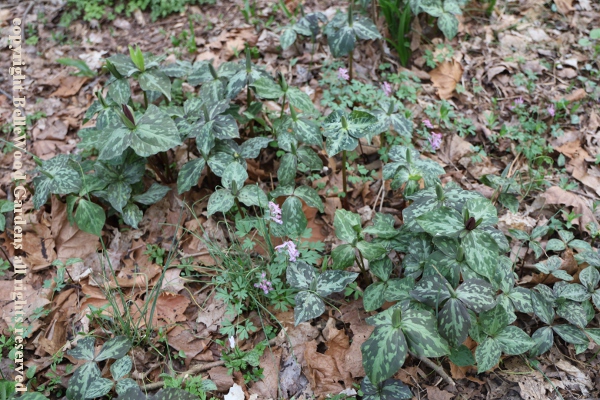
I have a nice colony of our native, sessile flowered Trillium cuneatum. It self-seeds. That is, it does so with help from ants. This is called myrmechory. The ants eat the fleshy eliasome, rich in lipids and proteins to attract them to each seed. The seed is then discarded, to sprout and grow. A year or so later there is a single small spade shaped leaf, and several years after that the tuber has grown large enough to flower.

It would be even nicer if the deer, those wretched appetites on cloven hooves, didn't eat them. They eat not just the sessile flower squatting down on the three leaves. No, the deer eat the leaves too. Each trillium tuber grow just that one trio of leaves each growing season. Being eaten means nutrients depleted in their growth cannot be replaced until the next growing season. This weakens the tuber. Milorganite helps as a repellent. I scatter it with ehthusiasm.
 .
.
Just a week on from my previous report and Fritillaria thunbergii is flowering
See the interesting curved hook on the upper leaves? If the plants were to grow
in brush they'd be used as tendrils, twining to take hold and scramble up. Nice!
Sunday, 4 April 2021

Another one of the true blue flowers of spring, daisy-like Anemone blanda.

Siberian squill, Scilla sibirica, has blue flowers that dangle like little bells.
 .
.
On the left, Fritillaria thunbergii as it is today. On the right, 3 weeks earlier on March 14.
Also known as F. verticillata, this bulb is native to Kazakhstan and in Xinjiang Province of
western China, naturalized in other parts of China and in Japan. Here it multiplies politely.

A little bulb which multiplies prolifically, flowers early in spring,
then disappears as trees leaf out. Name? Oh, it is Corydalis solida.

This time I'm certain of the name. It is Narcissus cyclamineus.

Another "perhaps" which I believe is Narcissus 'Mustard Seed'.

Not positively sure but I think this might be Narcissus 'Little Gem'.

More Christmas rose, Helleborus niger. Why niger or black
when it has such clean white flowers? The roots are black.

Virginia bluebells, Mertensia virginica, start to make its early appearance.
And afterwards it will fade away, disappear underground until next spring.

One of the sessile trilliums, with flower perched right on the three leaves.
Trillium cuneatum does well, seeds about. This year, deer are browsing.

An emerging shoot of Japanese woodland peony, Paeonia japonica.

Sunshine yellow forsythia. If it was difficult to grow we'd appreciate it more.

Star magnolia, Magnolia stellata, ready to open and live up to its name.
Saturday, 3 April 2021
In the Greenhouse

Unplanted, corpse flower, Amorphophallus, is pushing up a flower. I'll give it
another day or so, then chop it down before it opens and lives up to its name.



